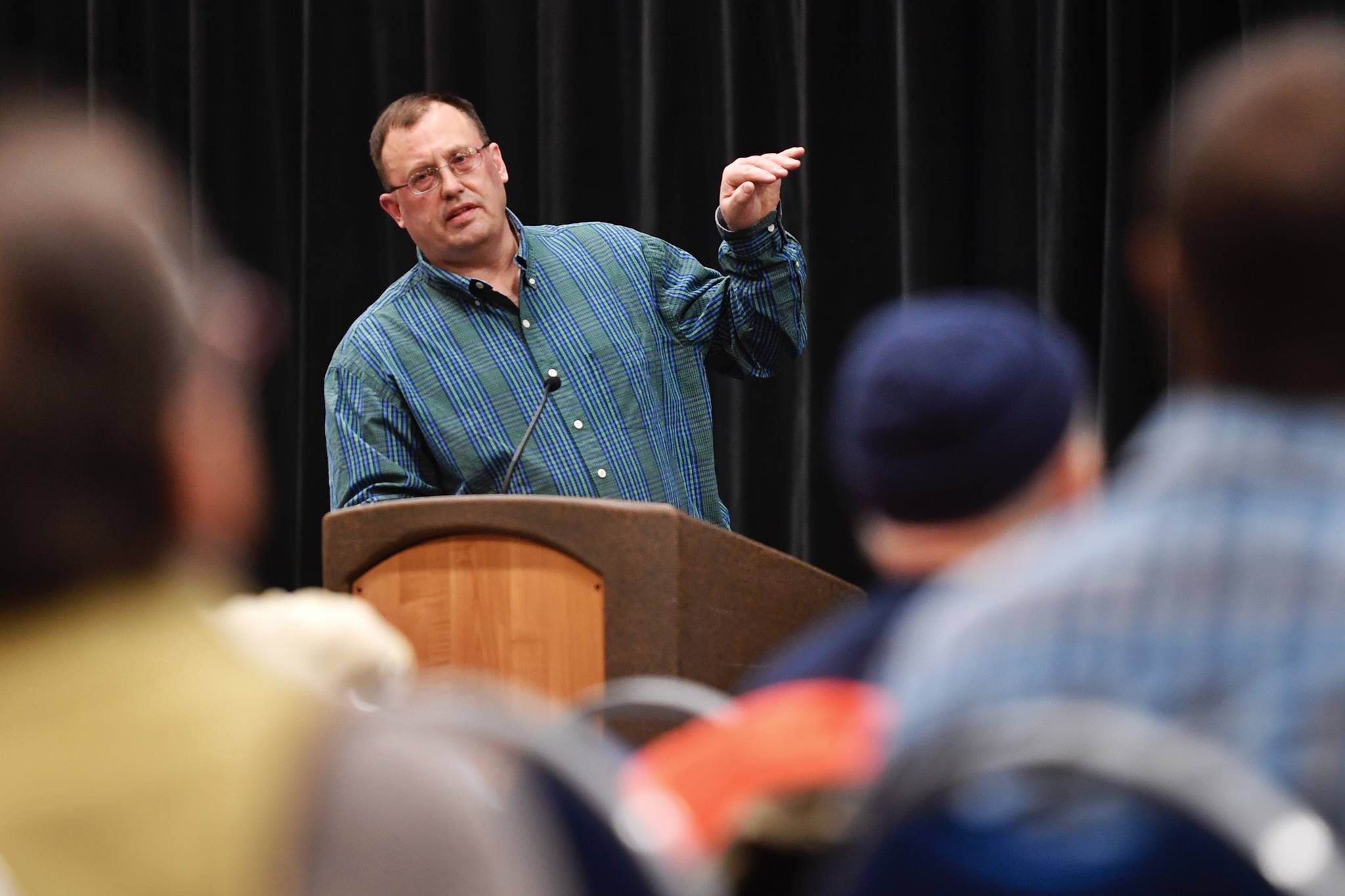Under the heading of “marine survival” in his slideshow, Phil Richards put a photo of the Grim Reaper walking along a beach and looking out over the ocean.
Richards, the Southeast chinook salmon stock assessment supervisor for the Alaska Department of Fish and Game, was presenting to a crowd of about 80 people at a Territorial Sportsmen King Salmon Symposium on Wednesday night. The image of the Grim Reaper looking out over the ocean was reminiscent of what Richards had said at the beginning of his presentation about what to expect from chinook salmon returns.
“For the next one to two years, it looks pretty grim,” Richards said.
Projections for chinook (king) salmon returns in the next couple years continue to be low — the Department of Fish and Game’s forecast for this season is the second-lowest since 1995, but is slightly better than last year’s forecast. Richards said the main problem is that when salmon head out into the ocean, fewer and fewer of them are coming back. This low marine survival rate is baffling and frustrating fish experts.
[Pink harvest lowest in 40 years]
Presenters and attendees at the annual symposium Wednesday exchanged theories. One attendee asked about who is trying to solve what he called “the mystery of ocean survival.” Ed Jones, the chinook salmon research initiative coordinator for ADF&G, said the University of Alaska and the National Oceanic and Atmospheric Administration (NOAA) are leading research into the issue. Jones said a warming ocean and the prevalence of predators are two significant factors, but there could be more to it.
“I don’t know that we’re ever going to pin that down,” Jones said. “I think, my personal opinion is, there are lots of factors that are affecting the survival of these fish in any given year. Obviously there’s something overwhelming that’s driving it right now.”
ADF&G expects 9,050 adult chinook will spawn on the Taku River, which means there is no allowable catch expected because the expected number is well below the escapement goal range of 19,000-36,000 fish, according to ADF&G’s forecast released in November. The report forecasts 8,250 chinook will spawn on the Stikine River, which is below the escapement goal range of 14,000-28,000 fish.
As a result of the low forecast, ADF&G is taking the same conservative approach as it took last year, limiting the number of chinook salmon people can catch. Dan Teske, Juneau area sport fish management biologist for ADF&G, said in his presentation that people are again forbidden to retain king salmon between April 1 and June 15, just like last year.
“For the sport angler, there are no major changes,” Teske said. “The major changes came last year.”
[Small Juneau hatchery helps with big ideas]
Part of the three-hour meeting at Centennial Hall was open for people to ask questions. The questions were all over the map, from asking about the effect that hatchery fish have on wild runs to oversight of tourism fishing companies to the role predators might play in the case of the disappearing salmon.
One of the anglers who attended the meeting and asked questions was Mark Vinsel. Vinsel, an avid sport fisherman, said there wasn’t anything new or groundbreaking presented during the meeting, but he thought it was still a valuable experience to get involved and get a look into the decision-making process for managing fisheries.
“It’s a little window, a little porthole of chinook, into the complexity of all the science and the management considerations for all the different users,” Vinsel said, “and also part of the public process by which these regulations come to be.”
For the most part, attendees and presenters were pessimistic about the short-term forecasts, using words like “cataclysmic” and “unprecedented” to describe the low returns and projections. During his presentation, Jones tried to stay positive. He pointed to Washington State’s Columbia River, which had abysmal salmon runs in the mid-2000s only to set records for salmon runs in the coming years.
Jones said he’s clinging to the hope that this is just a natural down cycle of returns and that things will return to normal soon. There isn’t any projection that sees that happening, he said, but he’s remaining hopeful.
“I will say we don’t see any light at the end of the tunnel right now in Southeast Alaska … but I do believe, I firmly believe, we’re going to cycle up out of this at some point,” Jones said.
• Contact reporter Alex McCarthy at amccarthy@juneauempire.com. Follow him on Twitter at @akmccarthy.

